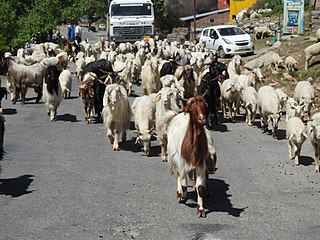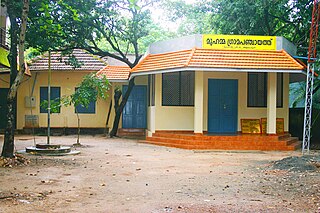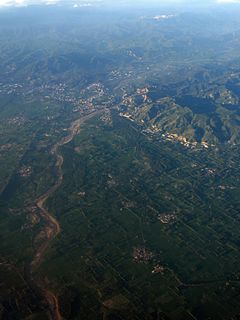Related Research Articles

Himachal Pradesh is a state in the northern part of India. Situated in the Western Himalayas, it is one of the eleven mountain states and is characterized by an extreme landscape featuring several peaks and extensive river systems. Himachal Pradesh shares borders with the Union territories of Jammu and Kashmir and Ladakh to the north, and the states of Punjab to the west, Haryana to the southwest, and Uttarakhand and Uttar Pradesh to the south. The state shares a border to the east with the Tibet Autonomous Region in China.

The Gaddis are a tribe living mainly in the Indian states of Himachal Pradesh and Jammu and Kashmir.

Dance in India comprises numerous styles of dances, generally classified as classical or folk. As with other aspects of Indian culture, different forms of dances originated in different parts of India, developed according to the local traditions and also imbibed elements from other parts of the country.

The Dogras or Dogra people, are an Indo-Aryan ethno-linguistic group in India and Pakistan consisting of the Dogri language speakers. Dogra ruled Jammu from the 19th century, when Gulab Singh was made a hereditary Raja of Jammu by the Sikh Emperor Maharaja Ranjit Singh, whilst his brother Dhian Singh was the empire's prime minister, until October 1947. Through the Treaty of Amritsar (1846), they acquired Kashmir as well. They live predominantly in the Jammu region of Jammu and Kashmir, and in adjoining areas of Punjab, Himachal Pradesh, and northeastern Pakistan. The Brahmin Dogras are predominantly Saraswat Brahmins, genetically of common origin with Saraswat Brahmins of Kashmir.

Panchayati Raj is the local self-government of villages in rural India as opposed to urban and suburban municipalities, this system was introduced by a constitutional amendment in 1992. Although it is based upon the historical panchayat system of the Indian subcontinent. The recommendation of LM Singhvi Committee (1986) was accepted. This Panchayati Raj system was formalized in 1992, following a study conducted by a number of Indian committees on various ways of implementing more decentralized administration. The modern Panchayati Raj and its Gram Panchayats are not to be confused with the extra-constitutional Khap Panchayats found in northern India.

Dasuya (Dasua) is a town and a municipal council in Hoshiarpur district in the state of Punjab, India. It is one of the major subdivisions with 398 villages under its jurisdiction.

Chamba is a town in the Chamba district in the Indian state of Himachal Pradesh. According to the 2001 Indian census, the town is situated on the banks of the Ravi River, at its confluence with the Sal River. Chambial were the Rulers of Chamba State Chambials use suffix Varmans.
Nirmala Devi, also known as Nirmala Arun, was an Indian film actress in the 1940s and a Hindustani classical vocalist of the Patiala Gharana. She is the mother of Bollywood actor Govinda.

Manimahesh Lake is a high altitude lake situated close to the Manimahesh Kailash Peak in the Pir Panjal Range of the Himalayas, in the Bharmour subdivision of Chamba district of the Indian state of Himachal Pradesh. The religious significance of this lake is next to that of the Lake Manasarovar in Tibet.

The Manimahesh Kailash Peak, 5,653 metres (18,547 ft), also known as Chamba Kailash, which stands towering high over the Manimahesh Lake, is believed to be the abode of Lord Shiva, the. It is located in the Bharmour subdivision of the Chamba district in the Indian state of Himachal Pradesh. The peak is 26 kilometres (16 mi) from Bharmour in the Budhil valley. It is one of the major pilgrimage sites as well as a popular trekking destination in Himachal Pradesh. The Manimahesh Lake is at the base of the Kailash peak at 3,950 metres (12,960 ft) and is also held in deep veneration by people of Himachal Pradesh, particularly the Gaddi tribe of the region. In the month of Bhadon, on the eighth day of the new moon period a fair is held in the precincts of the lake that attracts thousands of pilgrims.
Hāsya is a Sanskrit word for one of the nine rasas or bhava (mood) of Indian aesthetics, usually translated as humour or comedy. The colour associated with hasya is white and deity, Pramatha, and leads to exultation of the mind.
Tippani is form of folk dance originated from the Chorwad region of Saurashtra in Gujarat, India.

The karnal is a large, straight brass trumpet, over a metre long, played in parts of Northern India and Nepal. It has a prominent bell resembling a datura flower. It is used on ceremonial occasions, such as the processions of village deities. It is often included among the five instruments of the Nepali pancai baja ensemble.
The narsingha is a type of primitive trumpet used in parts of India and Nepal. The instrument is made of two metal curves, joined together to form an "S" shape.

Vijay Sharma is an Indian painter and art historian, known for his expertise in the Pahari school of miniature painting. He was honored by the Government of India, in 2012, with the fourth highest Indian civilian award of Padma Shri.
Gajendra Narayan Singh was an Indian musician, musicologist, writer, art historian and a former chairman of the Bihar Sangeet Natak Academy, the apex body of the Government of Bihar for music and drama. He is the author of four books on music, Mehfil, a historical reference book of music, Swar Gandh, a book of biosketches and music-related anecdotes, Kaljayee Sur: Pandit Bhimsen Joshi, a biographical work on the life and music of Bhimsen Joshi, and Surile Logon ki Sangath, which details the lives and music of some of the notable Hindustani classical musicians. His efforts are also known in promoting music and musicians of Bihar and he is reported to have initiated scholarship schemes for musicians during his tenure as the head of the Bihar Sangeet Natak Academy. The Government of India awarded him the fourth highest civilian honour of the Padma Shri, in 2007, for his contributions to Indian music. His life has been documented in an autobiography, Bihar ke Sangeeth Parampara, which was published by Delhi Public School, Ludhiana, in 2014.

The Markanda river in Himachal Pradesh and Haryana states of India is a tributary of Ghaggar river, flowing through Sirmaur District, Ambala district and Shahabad Markanda town in Kurukshetra district. The Markanda river's ancient name was Aruna.

Duni Chand Chambial, is a bilingual poet from Himachal Pradesh and a critic who has been editing Poetcrit, a reviewed international journal for the last thirty years. His poems have been translated into many languages.

Som Dutt Battu is a Shimla-based Hindustani classical vocalist of the Patiala Gharana. He was a winner of the civilian honour of Himachal Gaurav. He is also a member of Empanelment Committee for Hindustani Music at Indian Council for Cultural Relations New Delhi.
References
- ↑ Manorma Sharma (1 January 2007). Musical heritage of India. APH Publishing. pp. 81–. ISBN 978-81-313-0046-6 . Retrieved 29 March 2012.
- ↑ Manorma Sharma (1 January 1998). Tribal melodies of Himachal Pradesh: Gaddi folk music. APH Publishing. pp. 34–. ISBN 978-81-7024-912-2 . Retrieved 29 March 2012.